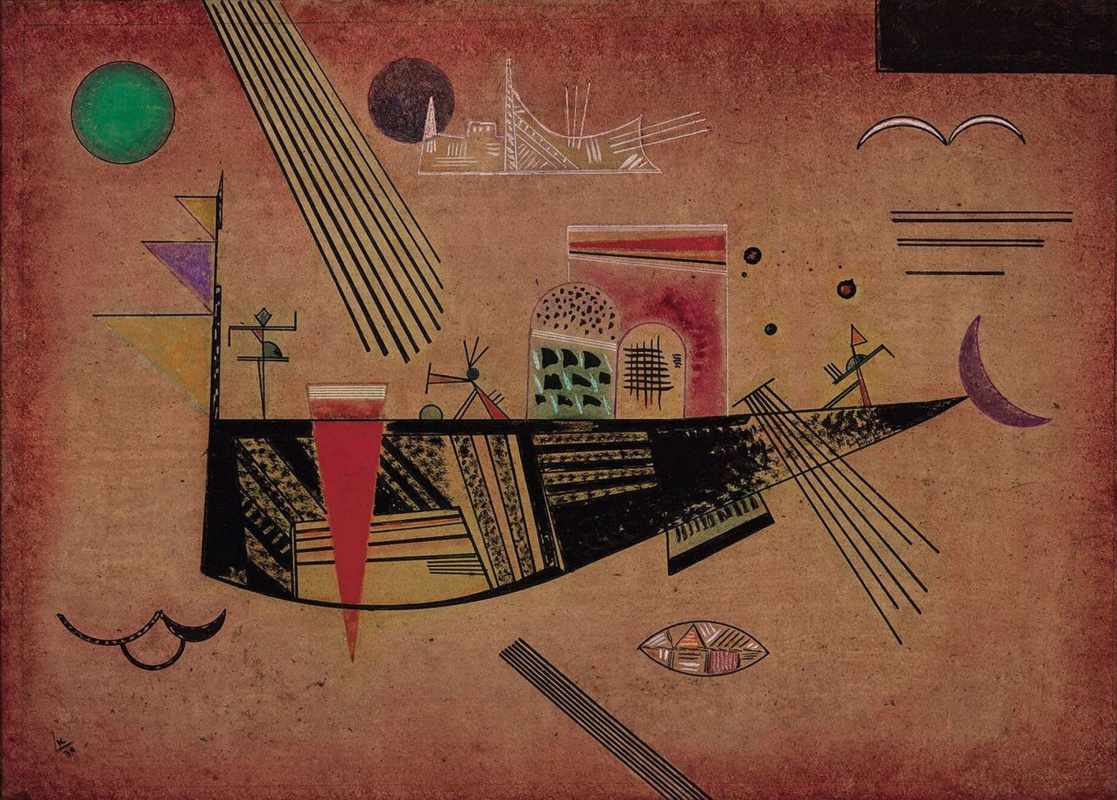log in
Enter site
Login to use Arthive functionality to the maximum
Capricious
Wassily Kandinsky • Painting, 1930, 40.5×56 cm
Description of the artwork «Capricious»
Wassily Kandinsky spent his childhood and youth at the seaside, in Odesa, and throughout his career, he often turned to the marine theme. Boats, ships, sails and various sea inhabitants appear in his paintings equally often in various periods of his creativity (1, 2, 3, 4, 5, 6, 7, 8). Capricious is no exception, one of the artist’s later works, the central part of which is occupied by a large ship, somewhat similar to a futuristic fish.
Despite his persistent desire to fulfil his almost religious artistic mission and serious research works in this area, Kandinsky was not alien to some playfulness, he could speak and write about art with witty comments, and some of his paintings (especially those of the late period) are humorous in nature. Viewer gets an impression that precisely because of his serious approach to creativity in the early years, Kandinsky can finally allow himself to add a certain ironic element to his pictures.
An attempt to penetrate the secrets of the Capricious painting leaves more questions than answers. At first glance, there is nothing unusual here: the central object of the picture most resembles a sea vessel. A number of details surrounding it only confirm this assumption: the elliptical shape under the hull of the ship is a fish, most probably, and the circle segments are a schematic representation of waves. The triangles on the masts are the signal flags, the superstructure on the deck is the captain’s bridge, and the dancing and gesturing figures are the crew.
However, do not forget about the abstract nature of the picture, according to which all the elements here are ambiguous, including even the uncertainty of the direction in which we think the ship is sailing. And if suppose that the ship is not a ship at all, and the water is not water, then we can see the image rather of some kind of a space ship drifting through the sky with two suns and a crescent. In this case, it is possible to build a completely plausible theory that Kandinsky anticipated the approaching space age, reviving the fantasy of science fiction writers on his canvas.
Written by Yevgheniia Sidelnikova
Despite his persistent desire to fulfil his almost religious artistic mission and serious research works in this area, Kandinsky was not alien to some playfulness, he could speak and write about art with witty comments, and some of his paintings (especially those of the late period) are humorous in nature. Viewer gets an impression that precisely because of his serious approach to creativity in the early years, Kandinsky can finally allow himself to add a certain ironic element to his pictures.
An attempt to penetrate the secrets of the Capricious painting leaves more questions than answers. At first glance, there is nothing unusual here: the central object of the picture most resembles a sea vessel. A number of details surrounding it only confirm this assumption: the elliptical shape under the hull of the ship is a fish, most probably, and the circle segments are a schematic representation of waves. The triangles on the masts are the signal flags, the superstructure on the deck is the captain’s bridge, and the dancing and gesturing figures are the crew.
However, do not forget about the abstract nature of the picture, according to which all the elements here are ambiguous, including even the uncertainty of the direction in which we think the ship is sailing. And if suppose that the ship is not a ship at all, and the water is not water, then we can see the image rather of some kind of a space ship drifting through the sky with two suns and a crescent. In this case, it is possible to build a completely plausible theory that Kandinsky anticipated the approaching space age, reviving the fantasy of science fiction writers on his canvas.
Written by Yevgheniia Sidelnikova


